Little Monsters - Part 35: Longhorn Beetle
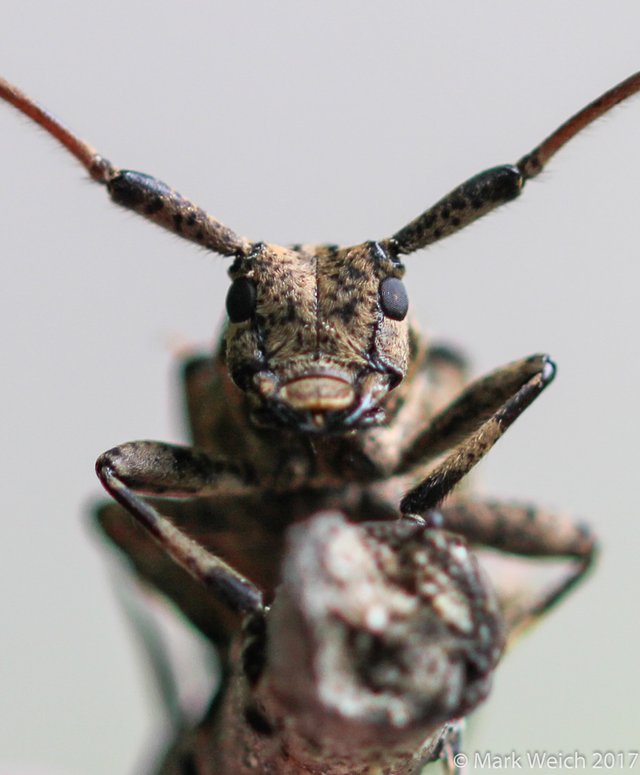
Longhorn beetles, or Borer Beetles are the scourge of many orchards and forests. The adults cut through the trees bark with their very strong jaws, to feed on the tree sap and to deposit their eggs. It is the larva that wreak the most destruction as they burrow through the bark disrupting the trees ability to transport water and nutrients up the trunk to the leaves.
This particular beetle, Mesosa longipennis or Nagagomafu Kamikiri, prefers cherry, fig and wisteria trees.
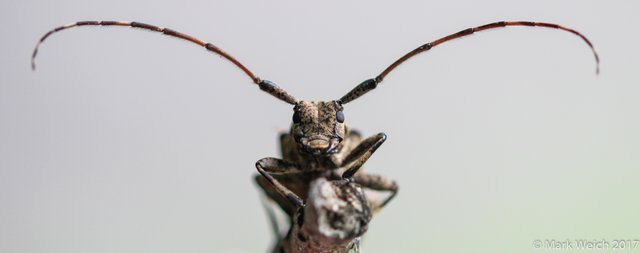
It's called the Longhorn beetle as it has very very long antenae. The first section, near the head, is much thicker and contains the muscles used to control long antenae; much like our forearms contain the muscles that control our hands and fingers.
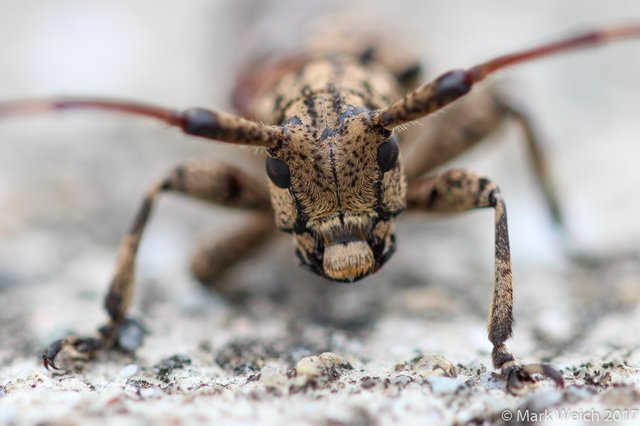
Though they look rough and scaly from from a distance, in reality they are covered in a multitude of small hairs!
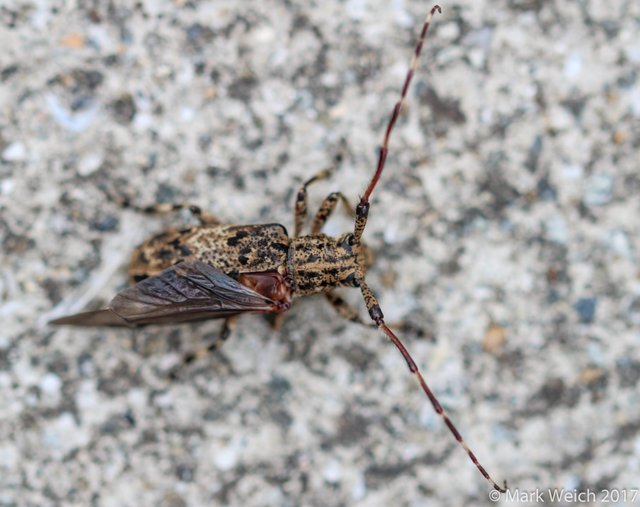
The first example of this species that I found that day had somehow lost one of its outer wings, in beetles these are modified to be hard shell like structures that protect the delicate flight wings beneath.
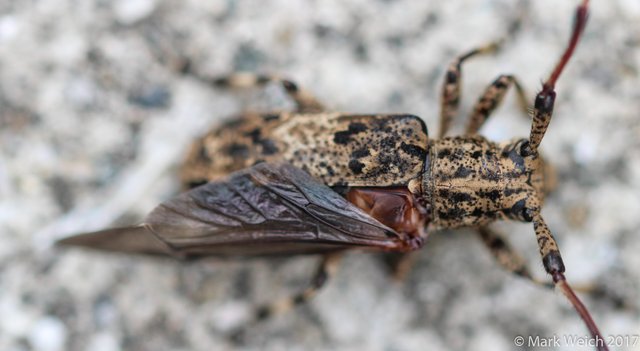
The flight wings are usually tucked in and folded much like origami. They need to be so large as the beetle is quite heavy for an insect, not folding the wings would have them trail behind suseptable to damage and ruining the camouflage pattern of the beetles exoskeleton.
Also, if you look closely at the image above, you can notice that in longhorn beetles the compound eye is shaped like the letter "C" and wraps around the base of the antenae.
Here, I set the focus on the mandibles:
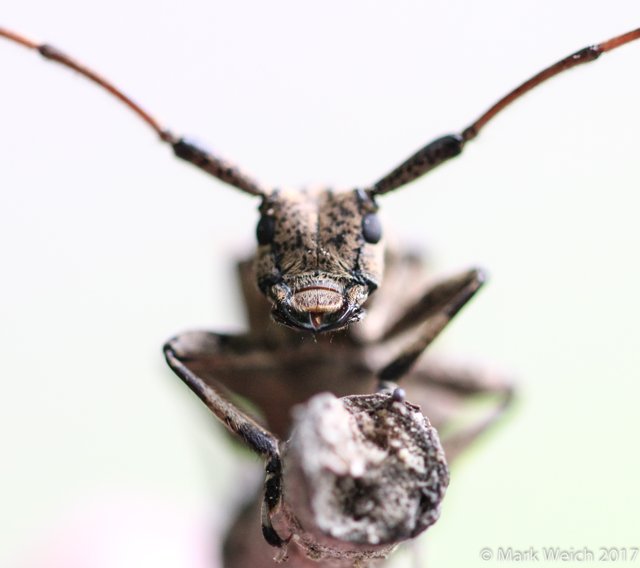
They are quite strong, used to cut through tree bark. The beetles usually tuck their legs and antenae next to the body and drop to the ground when disturbed. It's actually quite difficult to find them later as they blend in very well!
They also squeak when disturbed, the first beetle (on the ground) protested in a little voice as I gently nudged it into a better position. "eeeeeeeeeeeee...eeeeeeeeeeee..."
After taking the pictures I left it near a tree, off the road where I found it.
Though they are pests and can damage crops they are still living creatures and should be respected!
Sources: Species ID, diet etc Insects.jp
Comments and feedback are always welcome.
Please upvote and follow to see the next installment in your feed!
Resteem if you think your followers would enjoy this post, thanks!
Also, if you like macro photography, check out some of the earlier posts in this series.
Little Monsters - Part I: Wolf Spiders
Little Monsters - Part II: Golden Orb Weaver
Little Monsters - Part III: Lynx Spiders!
Little Monsters - Part IV: Decorator Orb Weaver
Little Monsters - Part V: Black Back Paper Wasp
Little Monsters - Part VI: Dragonfly
Little Monsters - Part VII: Indian Fritallary
Little Monsters - Part VIII: Giant Japanese Hornet
Little Monsters - Part IX: Praying Mantis!
Little Monsters - Part X: Harlequin Ladybird!
Little Monsters - Part XI: Dragons!
Little Monsters - Part XII: Snails!
Little Monsters - Part XIII: Evil Weevils!
Little Monsters - Part XIV: Fantastic Phasmids!
Little Monsters - Part XV: To Bee or not to Bee?
Little Monsters - Part 16: Jumping Spiders!
Little Monsters - Part 17: Hawkmoth Caterpillars and Hawkmoths
Little Monsters - Part 18: Evil Doppelgangers - The Ant Mimic Spider
Little Monsters - Part 19: Hummingbird Hawkmoth!
Little Monsters - Part 20: Loud and Proud the Cicada!
Little Monsters - Part 21: Great Green Caterpillars!
Little Monsters - Part 22: Vespa mandarina japonica
Little Monsters - Part 23: Little Black Ants
Little Monsters - Part 24: Cranes and Robbers
Little Monsters - Part 25: Hidden in the Grass
Little Monsters - Part 26: Ammophila, Alien is real!
Little Monsters - Part 27: Bush Cricket
Little Monsters - Part 28: Butterflies, flying bits of colour!
Little Monsters - Part 29: Hermit Crabs!
Little Monsters - Part 30: Redback Spider
Little Monsters - Part 31: Harlequin Ladybird Larva
Little Monsters - Part 32: Small Cabbage White
Little Monsters - Part 33: Jumping Spiders II Evarcha albaria
Little Monsters - Part 33 II: More Jumping Spiders!
Little Monsters - Part 34: Crab Spider!
I maintain and reserve copyright on all of my photos.
Written with StackEdit.
Good shots. I am not familiar with this little guy.
They are well camouflaged, very easy to miss!
man those ..mouth? mandibles?
how do you call that?
Mandibles is the correct term for the two pincer like mouth parts, but together they are a part of the mouth of the insect.
I thought mandibles are only for crabs but these look like those
hey you .. throw plenty of pics
you'll pump it up
Keep your spirit up!
All arthropods have mandibles, the parts used for gripping and cutting food and things. Even vertebrates have mandibles but in that case it refers to the lower jaw bone. :)
well .. thanks for clarifying that ")
Great shots
Thank you very much @halo!
very nice photography great shotsss
Thank you very much @nomi2233!
I've listened to insects chewing away inside of trees, but I never knew that borers made sounds like you described. Pretty amazing!
Yeah, it was a little squeaky buzz, just voicing it's displeasure I guess.
There is so much to insects that we just don't know. They are so different from us. But we all need to squeak with displeasure sometimes! :O
Absolutely!
Scary!
Thanks! I'm always extra careful when handling any of these beetles, fingers are much softer than tree bark after all!
Awesome macros once again @mweich, it's getting harder and harder to track all my fellow photographers' work here on Steemit!
Yeah, lots of good photographers, so little time! It'll only get worse/better as the platform grows. Thanks for taking the time to get out my work!